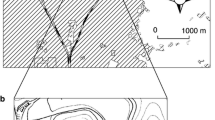Abstract
We conducted field studies to evaluate the impact that curculio weevil attacks on Pasania edulis (Fagacea) acorns have on the regeneration of this tree. The germination ratio of weevil-attacked acorns was significantly lower than that of sound acorns. The number and position of the attacks on acorns affected the germination ratio. The seedlings from weevil-attacked acorns were shorter and had a smaller leaf area than those from sound acorns. The negative effects on seedling height lasted for at least three years after germination. We also studied the handling of the two types of acorns by granivorous Apodemus mice in a broad-leaved forest dominated by P. edulis. The mice picked up, transported, hoarded, and recovered sound and weevil-attacked acorns similarly. In the study site, the seedlings from weevil-attacked acorns were estimated to account for 1.5–20.4 % of the total seedlings for cohorts of mast years and 0–3.7 % for those of poor or medium acorn production. From these results, we conclude that acorns with the lower part of their cotyledons slightly damaged by weevil larvae might still be able to contribute to the regeneration of P. edulis in the field but that their contribution would be negligible or small even in mast years in this study site.

Similar content being viewed by others
References
Akashi N (1997) Dispersion pattern and mortality of seeds and seedlings of Fagus crenata Blume in a cool temperate forest in western Japan. Ecol Res 12:159–165
Andersen AN (1989) How important is seed predation to recruitment in stable populations of long-lived perennials? Oecologia 81:310–315
Bonfil C (1998) The effects of seed size, cotyledon reserves, and herbivory on seedling survival and growth in Quercus rugosa and Q. laurina (Fagaceae). Am J Bot 85:79–87
Forget P-M, Kitajima K, Foster RB (1999) Pre- and post-dispersal seed predation in Tachigali versicolor (Caesalpiniaceae): effects of timing and variation among trees. J Trop Ecol 15:61–81
Fukumoto H, Kajimura H (2000) Effects of insect predation on hypocotyl survival and germination success of mature Quercus variabilis acorns. J For Res 5:31–35
Gurnell J (1993) Tree seed production and food conditions for rodents in an oak wood in southern England. Forestry 66:291–315
Hirata R, Takamatsu N, Nakamura M, Fuchigami M, Hata K, Sone K (2007) Secondary dispersal of Pasania edulis acorns by Apodemus speciosus into a coniferous plantation. J Jpn For Soc 89:113–120 (in Japanese with English summary)
Iida S (2006) Dispersal patterns of Quercus serrata acorns by wood mice in and around canopy gaps in a temperate forest. For Ecol Manage 227:71–78
Kormanik PP, Sun SS, Kormanik TL, Schlarbaum SE, Zarnoch SJ (1988) Effects of acorn size on development of northern red oak (1-0) seedlings. Can J For Res 28:1805–1813
Maeto K (1995) Relationship between size and mortality of Quercus mongolica var. grosseserrata acorns due to pre-dispersal infestation by frugivorous insects. J Jpn For Soc 77:213–219
Matsuda K (1982) Studies on the early phase of the regeneration of konara oak (Quercus serrata Thumb.) secondary forest. 1. Development and premature abscission of konara oak acorns. Jap J Ecol 32:293–302
Matsuda K (1989) Survival and growth of konara oak (Quercus serrata Thunb.) seedlings in an abandoned coppice forest. Ecol Res 4:309–321
Nakamura M, Hirata R, Oishi K, Arakaki T, Takamatsu N, Hata K, Sone K (2013) Determinant factors in the seedling establishment of Pasania edulis (Makino) Makino. Ecol Res 28:811–820
Nilsson SG (1985) Ecological and evolutionary interactions between reproduction of beech Fagus silvatica and seed eating animals. Oikos 44:157–164
Sone K, Kohno A (1996) Application of radiotelemetry to survey of acorn dispersal by Apodemus mice. Ecol Res 11:187–192
Sone K, Kohno A (1999) Acorn hoarding by the field mouse, Apodemus speciosus Temminck (Rodentia: Muridae). J For Res 4:167–175
Sone K, Hiroi S, Nagahama D, Ohkubo C, Nakano E, Murao S, Hata K (2002) Hoarding of acorns by granivorous mice and its role in the population processes of Pasania edulis (Makino) Makino. Ecol Res 17:553–564
Takahashi K, Sato K, Washitani I (2006) The role of the wood mouse in Quercus serrata acorn dispersal in abandoned cut-over land. For Ecol Manage 229:120–127
Ueda A (1996) Insect infestation on acorns of Japanese chestnut, Castania crenata Sieb. et Zucc., in natural forest. Trans Jpn For Soc 107:233–236 (in Japanese)
Ueda A, Igarashi M, Ito K (1993) Acorn infestation by insects on three evergreen oaks, Quercus glauca, Q. myrsinaefolia and Pasania edulis. (II). Their invasion term and level after acorn dropping. Trans Jpn For Soc 104:681–684 (in Japanese)
Vander Wall SB (1990) Food hoarding in animals. University of Chicago Press, Chicago
Xiao Z, Jansen PA, Zhang Z (2006) Using seed-tagging methods for assessing post-dispersal seed fate in rodent-dispersed trees. For Ecol Manage 223:18–23
Yamagawa H, Ikebuchi M, Ito S, Ito H, Hirata R (2010) Acorn dispersal by wood mice in a secondary lucidophyllous forest on a steep slope in a warm-temperate region of Japan. J Jpn For Soc 92:157–161 (in Japanese with English summary)
Yu X, Zhon H, Luo T (2003) Spatial and temporal variations in insect-infested acorn fall in Quercus liaotungensis forest in north China. Ecol Res 18:155–164
Acknowledgments
This study was financially supported by a Grant-in-Aid for Scientific Research (No. 25660119).
Author information
Authors and Affiliations
Corresponding author
About this article
Cite this article
Sone, K., Oishi, K., Shibato, T. et al. Effects of acorn attack by curculio weevils on the germination and early growth of Pasania edulis (Makino) seedlings. J For Res 21, 185–192 (2016). https://doi.org/10.1007/s10310-016-0531-8
Received:
Accepted:
Published:
Issue Date:
DOI: https://doi.org/10.1007/s10310-016-0531-8




